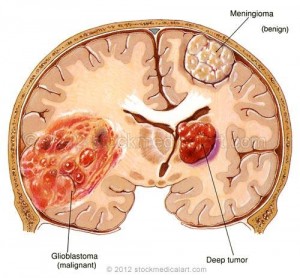Researchers receive inspiration from a variety of sources, this post follows an innovation which was inspired from Yamanaka’s Nobel Prize on cellular reprogramming.
The advancements made in the cancer research field have been extraordinary. However, there still remain certain types of cancer that reduce a patients life expectancy greatly. Glioblastoma (GBM) is a tumour that arises from supportive tissue in the brain which is located in the cerebral hemisphere (Figure 1). Once diagnosed this disease leaves a patient with a life expectancy of one to two years. Glioblastoma tumours are often very cancerous because the cells can reproduce rather quickly. One of the main reasons this disease has a low life expectancy is because though a surgeon may operate and remove the main cancer; the possibility of parts of the cancerous tumour moving deeper into the brain and reforming are high. Therefore, glioblastoma cannot be completely rid of just by surgery.
The following image shows three types of brain cancer and their respective locations, this innovation focuses on glioblastoma.

Figure 1. Location of the glioblastoma – Credit: Stockmedicalalert.com
Researchers at the University of North Carolina have been working on transforming ordinary skin cells into cancer-hunting stem cells that can get rid of glioblastoma. The work of these individuals was posted in Nature Communications and the idea was to transform stem cells into cells that can actively act as cancer fighting cells.
The ability to reprogram fibroblast (cells which produce collagen and connective tissue) cells into induced neural stem cells, which are self-renewing cells, is how these researchers aim to kill cancer cells. The induced neural stem cells also contain an extra additive, a killing protein, making it more effective at killing the cancerous cells.
This innovation been tested using mice. This showed how the neural stem cells can actively move through the brain and find and kill any remaining cancer cells that surgery may have been unable to get rid of. In the tested mice the survival rate increased from 160 to 220 percent due to this innovation.
The following video gives a brief overview of the research described in this post.
https://www.youtube.com/watch?v=sjK5HJKj7f8
Credit: NewsBeat Social
This innovation is of much interest to individuals who battle glioblastoma. However, this study needs to undergo many safety checks before it can be administered to individuals. The researchers believe there is about one year until they reach clinical trials.
Although this research has the potential to be life-changing for individuals battling glioblastoma, it is important to question the practicality of the research. For example, will this innovation increase the life expectancy slightly or will this eliminate all of the leftover cancer cells in the brain. Unfortunately, this cannot be answered at such early stages in the research, however the results do look promising and it seems to be headed in the right direction.
-Vanessa
